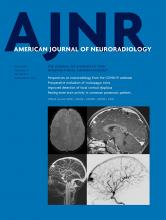We would like to thank Drs Middlebrooks and Sabsevitz for their interesting comment on our recent publication, “Lesion-Specific Language Network Alterations in Temporal Lobe Epilepsy.”1 In this group analysis of patients with temporal lobe epilepsy (TLE) due to different underlying pathologies, we targeted the main question: Can distinct lesion-specific language network changes be identified using functional connectivity (FC) analysis? Indeed, we showed that different etiologies (ie, hippocampal sclerosis, nonlesional temporal lobe epilepsy, and mesiotemporal low-grade glioma) of TLE cause distinct patterns of language network changes.
We agree with the authors that a critical appraisal of the paradigm design is extremely important in presurgical fMRI. However, we would like to emphasize that due the robustness of our FC group analysis results, the main results are very unlikely to change, even after choosing a different paradigm approach. We would like to further comment on the points mentioned.
As outlined in the authors’ comment, Binder et al2 found a significant difference between auditory semantic language tasks with rest versus active, nonlinguistic tasks as a baseline condition.2 Auditory tasks, as exclusively used in the study by Binder et al, cannot be simply extrapolated to our visually presented language paradigms using cross-fixation (with/without alternating hashtags) as a baseline task. The use of cross-fixation as a baseline is common3 and recommended by the American Society of Functional Neuroradiology in their recently published guideline article (see, for instance, the “Antonym Generation” paradigm).4 As expected, cross-fixation typically results in bilateral activations in the primary visual cortex,4 which need to be considered when interpreting the results. Furthermore, we would like to stress that using a homogeneous protocol (ie, the same scanner, same task design, systematic prescanning patient training, quality assessment by on-line processing during fMRI acquisition, the same processing, and the same analysis parameters), we could reduce the risk of a systematic bias. However, we do agree that potential intersubject differences in the ability to “rest” during cross-fixation could have translated into subtle differences of network characteristics.
To our knowledge, the examined etiologies were never proved to differ in the patients’ ability to optimally adhere to the baseline task. Moreover, many of the included patients scored low on verbal fluency and naming tests (36.8% and 69.1%, respectively). Although no group differences were found in their actual language abilities, these facts strongly suggest that the observed lesion-specific changes can be explained by functional connectivity changes in the language domain and not, as otherwise assumed, by differences in baseline task completion.
We do agree that task-based fMRI, regardless of whether active or cross-fixation is used as baseline condition, is not equivalent to pure resting-state fMRI. We absolutely do not and did not recommend to either replace task-based fMRI by resting-state fMRI or vice versa. For the investigation of specific cognitive networks, such as language in our case, task-based fMRI may be superior to resting-state fMRI due to its higher reliability and robustness.5 As outlined in our Materials and Methods section,1 we included all acquired time points (n = 100 per run) into our FC analysis in order not to introduce artificial fluctuations into the frequency spectrum by cutting and concatenating task and resting blocks.6 Moreover, this approach should maximize the available number of time points, which is known to critically influence the reliability of connectivity measures.7 In our opinion, activation analysis and FC are complementary approaches. However, before the full transition of functional connectivity from research to clinics, further studies on the reproducibility and interpretation of these correlation values on a single-subject level are needed. One such promising approach could be connectivity fingerprints, in which individual network features are compared with normative values derived from a large pool of healthy subjects, as recently attempted.8-10
References
- © 2020 by American Journal of Neuroradiology












